Lining a pond bank with rock can help with bank erosion and water turbidity caused by it.
Happened to be out yesterday and noticed a muddy streak of water heading off across the pond. It was a very windy day. It looked like the muddy streak was coming from somewhere out in the pond toward the bank.
Upon further examination the muddy water was in fact coming from a small portion of the bank which had exposed clay. The waves were washing the clay into suspension then the undertow current was taking the muddy water out in the opposite direction of the wind and waves. So what looked like muddy water coming in from the center of the pond was actually muddy water moving out.
Earlier this summer I had taken the backhoe and deepened this area of the pond shoreline. What originally was intended as a swimming area with a gently sloping bank lined with fine gravel (man sand) turned into a huge FA bed. I also found we really liked swimming off the dock instead of the bank anyway. So this area was deepened. Most of the near shore was still rock lined though.
But in one small area the backhoe had come close enough to the high water line that clay was exposed. This small area was where the turbid water was coming from. Took the loader and sprinkled 2-3" rock out into the water in this area and shortly the streak of muddy water was starting to go away. The rocks were breaking up the water and discouraging the clay to go into suspension. Problem solved.
Point is, rock lining around a pond shoreline will definitely help with pond turbidity if the pond is exposed to wind and the dirt or clay is prone to suspension. My shorelines covered in rock are slowly becoming vegetated and eventually will not even visually be able to tell the rock was ever there. But it will still be there, below the roots of the plants, in case wave erosion tries to dislodge some of my bank.
Thought some might be interested in the pictures. The first and second pictures are of the bank area showing the turbidity caused by the erosion (003 and 005). The last picture (004) is a portion of the bank a few feet away where the rock is properly protecting from erosion and showing clear water like it should be.
Without the rock lining the shore line I'm satisfied that at least part of the time I would have a muddy looking pond. Just this small 3' of unprotected section with the waves pounding it was causing a significant streak of muddy water flowing out toward the pond center.



Description: bank erosion causing turbid water

Description: wider angle of same area

Description: adjacent shore for comparison where erosion is not taking place

Here are a couple other threads concerning lining the bank with rock or rip-rap. Some like it, some don't. Having read these in the past was what caused me to think of doing the above post just to show how in some cases rock lining the shore line can be helpful.
Limestone rock around pond Soggy Shoreline
Look great snrub! Are you sure you didn't expose that area just so you could play with the big Tonka toys later???

Here is an update. When I sprinkled the rock in the water to stop the bank erosion and resulting turbidity I could see results within minutes. Within hours the pond had mostly cleared up with the bank no longer adding suspended clay.
When adding the rock, the water was muddy so I could not see what I was doing. By just gently tapping the loader bucket controls while moving forward was trying to spread a thin layer of rock over the bare area.
The two photos below were taken today around noon or about 3/4 of a day after adding the small area of rock (only the width of the loader bucked or about 6').
As you can see I did not get perfect coverage. There are still some clay spots bare but the bare spots are not very big. No wind today so the water is very clear and easy to see the added rocks. What I want to show is that even though I did not get complete rock coverage, there was enough rock to break up the current created from the wave action to stop the erosion.
When scuba diving in high water current situations divers quickly learn to not burn up their air supply and energy by trying to swim against the current. By ducking behind a coral head or any obstruction on the bottom, the current is broken up and the water travels above the tops of the obstructions. Same principal with this rock on the bank. Even though there is not perfect coverage, the rock that is there was enough to break up the current and make it travel a couple inches higher above the clay.
I'll go ahead and put a little more rock there now that I can see what I'm doing. But I wanted to show that even without complete rock coverage, the rocks were doing their job by breaking up the current caused by the wave action and stopping the resulting shore line erosion and water turbidity.
Description: new rock "sprinkled" with loader into turbid water area
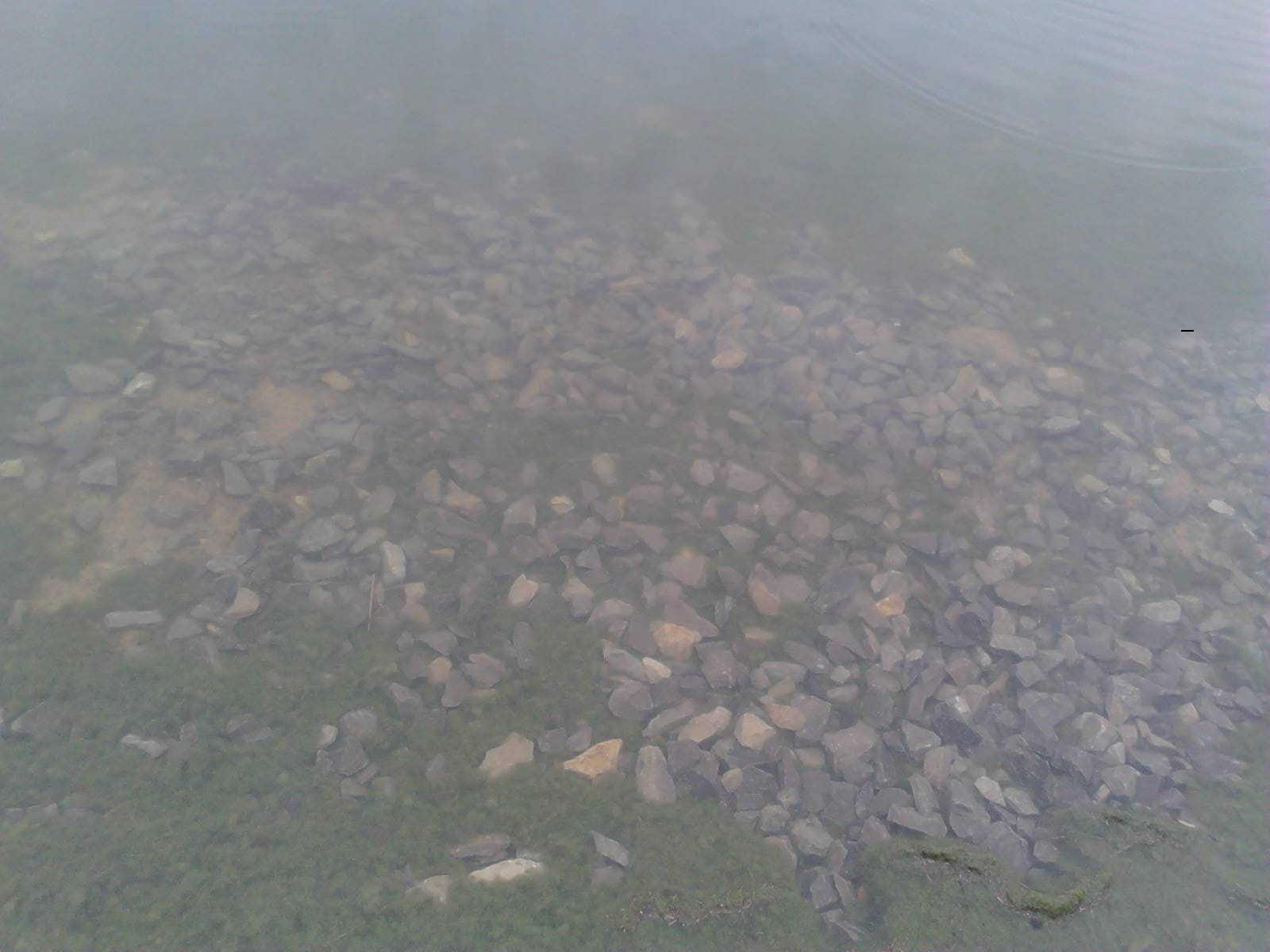
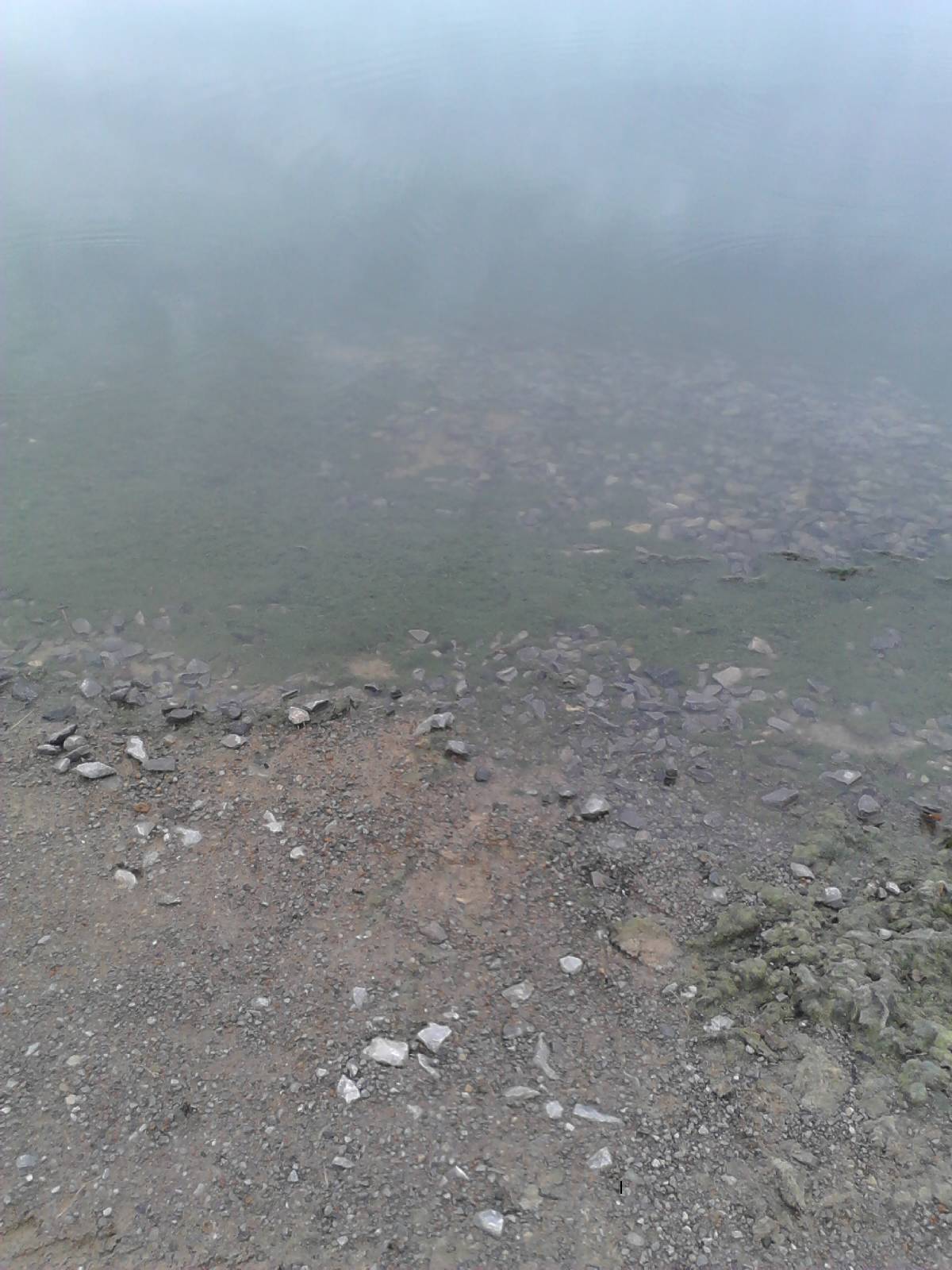
Description: results = no turbidity

PBer's,
In your experience (and opinion), does smaller size ( < / = 1"), medium size (1 -3"), or large size (3-5") limestone work best at keeping turbidity to a minimum around your pond? My ryegrass is coming in, but I'm still having an issue with erosion from the clay banks.
Any opinions will be appreciated.
Average wave size would determine rock size...heavier wave action will mean heavier stone needed. The steepness will matter also...a shallow slope, the waves break easier...sharper slopes, the waves will crash into harder.
Thanks, Rainman...the local aggregate yard sells it in 3 different sizes (listed above) and I was unsure of which way to go. I think the smallest size offered will work best for my little pond. We don't get much wave action up in the piney woods. I think the smaller size will pack down better as well.
The finer stuff will tend to wash down the bank worse, especially on a steeper bank. Stuff too big is hard to walk on.
What I like to do the best is put a thin layer of larger rock, as thin as a single rock thickness. 2-4" stuff I like best. Then a layer of finer stuff over the top. 0-2".
Like was said, if the bank is steeper, (steeper than 4:1 in my opinion) you might want to make a "curb" where you want the rock to stop at, or it might just find it's way to the bottom of the pond.
If you don't put down geotextile fabric under the rock, it'll work it's way into the soil over time. Smaller rock will work in quicker than larger rock.
Larger rock, if below the waterline, will provide habitat and cover for invertebrates like crayfish. They will be able to hide between or under the rocks.
Smaller rocks pack too tightly together and don't leave room for them. I've seen RES making spawing beds on 3/4"-1" river rock beds.
PBer's,
In your experience (and opinion), does smaller size ( < / = 1"), medium size (1 -3"), or large size (3-5") limestone work best at keeping turbidity to a minimum around your pond? My ryegrass is coming in, but I'm still having an issue with erosion from the clay banks.
Just for reference, the rock that I "sprinkled" into the water that you can see in the second set of pictures was mostly in the 2-3" range. It is what we use in this area for rock in the lateral drain field of a septic tank sewage system and is locally called "lateral rock" at the limestone quarry.
And Rainman, it is not hard to look around the farmstead and see places to use the "Tonka toys". But most of it involves "work" and I prefer the projects that are "play".

The banks of my pond are very gradual on 3 sides, however the dam side slope is a bit more aggressive. Most of my erosion issues come from the gradual sloping watershed sides. I'm going to have to make a decision and live with it. Thanks, for all the input. Im leaning towards medium size aggregate. I priced a 13 ton (dump truck) load of limestone for $600.00 delivered...does that sound competitive?
The banks of my pond are very gradual on 3 sides, however the dam side slope is a bit more aggressive. Most of my erosion issues come from the gradual sloping watershed sides. I'm going to have to make a decision and live with it. Thanks, for all the input. Im leaning towards medium size aggregate. I priced a 13 ton (dump truck) load of limestone for $600.00 delivered...does that sound competitive?
Sounds high for my area. We just had 40 tons of #2 stone delivered and spread on a soft roadbed, and the bill was far less than $600.
A lot depends on how far they have to truck it.
Sparkplug,
They are a local outfit...they indicated that there would be no delivery charges. Maybe, I need to do a little more investigation on the subject. Thank you, for your input.
$600 sounds way high! 13 ton of rock is not all that much either...
Rainman,
I've never purchased aggregate of any kind in bulk and I'm ignorant of rock pricing. Thanks, for your and Sparkplug's candor. That's one of the reasons that I value this forum.
Is it true that a square yard of limestone is just over a ton in weight? This same business indicated that a 13 ton load of limestone would measure approximately 11 sq. yards. I have no idea.
Being an engineer, I could not help rising to this bait. Limestone comes in low, medium and high density sooooo..a 1 yard block of limestone weighs between 3000 and 4300 pounds. So the 2000 pound for aggregate could be close if it is low density stuff and then again size matters in this case!
Stickem, are you referring to square yards or cubic yards? Also, what size stone are they quoting you?
Sparkplug, they were referring to cubic yards as in a load in a dump truck. They indicated a 13 ton load = ~11 cubic yards. Small sizes up to 5" for $600.00. Sizes 5" and larger $650.00 (same size weight load).
Bill D., interesting! Thanks, for crunching the numbers.
Now I see the cost. Ask them what the price on a load of #2 stone would be. My experience with stone "size does matter." The bigger the stone, the more it costs!
I'm with Bill, things make a little more sense now. I am a little curious when they say up to 5"....lot of room for interpretation there. What are they calling this particular size? (up to 5")
One thing that makes a lot of difference in the coverage a person gets per ton of rock is if it has fines or has been screened to remove fines.
Fines have their place. If a person needs the rock to "pack" finer particles are essential.
But a person will get more coverage, or in other words a bigger volume load, if the fines are removed. Rock with the fines removed is lighter per volume than the same maximum size rock with fines.
It is like filling a jar with marbles. When filled it will weigh a certain amount. But if sand is added and the jar shaken so the sand will fill the pores between the marbles, the same volume container will weigh more with the sand (fines) than without the fines.
Graded rock with the fines removed usually is higher priced per ton than rock with the fines included. For a road where it needs to pack using this cheaper per ton rock works well. But rocks with the fines removed will go further because there is more volume. The same number of tons in a truck load will result in a significantly larger volume load of rock with fines removed than with fines left in. It costs a little more per ton (because it costs to run the rock over more screens to remove the fines) but will have significant better coverage in applications where the fines are not needed or not desired. Cheaper per ton does not always translate to cheaper per project.
For bank erosion control the rock with fines removed will go farther. On the other hand, if the pond could use additional lime anyway (is acidic). Much of the fines will wash into the water with wave action and be of benefit.
So which to use? It depends.
If I was doing it and wave action was not huge and cost was a consideration............rip-rap is pretty cheap.
Sparkplug, no I used the term "up to 5 inch"...they used the term "5 inches and smaller"...there are many aggregate sizes; > 1", 1 to 2", 2 to 3", 3 to 5" and larger.
Sparkplug, no I used the term "up to 5 inch"...they used the term "5 inches and smaller"...there are many aggregate sizes; > 1", 1 to 2", 2 to 3", 3 to 5" and larger.
While I've never bought stone in Texas, I will admit to being baffled by this particular grading system. Here, stone is bought by the grade, or number. The larger the number, the smaller the stone GENERALLY.
For a new driveway, I like #2 for a base (average around 3-4" or so), and then top dress it with #8 (3/4-1"). #11 is about the size of a fingernail.
Same here except I use #9 for the top dress. I really can't give you a reason why other than that is what my dad always did on the farm and it always seems to pack well.
I will get back with the aggregate supplier and advise. Thanks to all. I'm learning a lot. Great subject for a post!
I apologize now for what is to come but the subject has me making a stroll down memory lane. My dad also always lined the feed lot for the cattle we were fattening for our table and friend's tables with #2. His claim was the cattle did not like walking on it so all they did was eat, drink and lay down. Minimal muscle strength so very tender. Have to admit I never had a tough steak when growing up!
I find the sizes some talk about on here completely foreign compared to what we get quoted locally.
Here is a PDF of rock sizes available at one of several different local quarry's.
Midwest minerals products I don't know what many of the designations are. You can see that KDOT has their own specs.
AB3 is what we use to top roads and driveways as it has everything from about 1" down in size, with considerable fines for good packing.
2 1/2x 1 1/2 is what you see in my pictures of the stuff I sprinkled in the water. (used for lateral rock in septic sewage systems) What it means is everything that will pass through a 2 1/2" screen then taking out everything that will pass through a 1 1/2" screen ( in other words fines removed). The 2 1/2 x 0 means everything that will pass through a 2 1/2" screen including all fines.
Shot rock is loaded right from the explosive blast without being processed. I've only used it once in a crossing where we needed a lot of fill and some big rock. A couple of the rocks were 3' in diameter with everything below that without being run through a crusher.
I think the ASTM stuff is for concrete. I've been using ASTM 3/4 and man sand to make concrete around the farm for various projects. The man sand is more like chat and can't be finished like concrete with sand in it can.
Lots of rock grades on that chart I don't know what they are. If I need something other than what I've been using, best to just go to the quarry and look see what is in the piles.
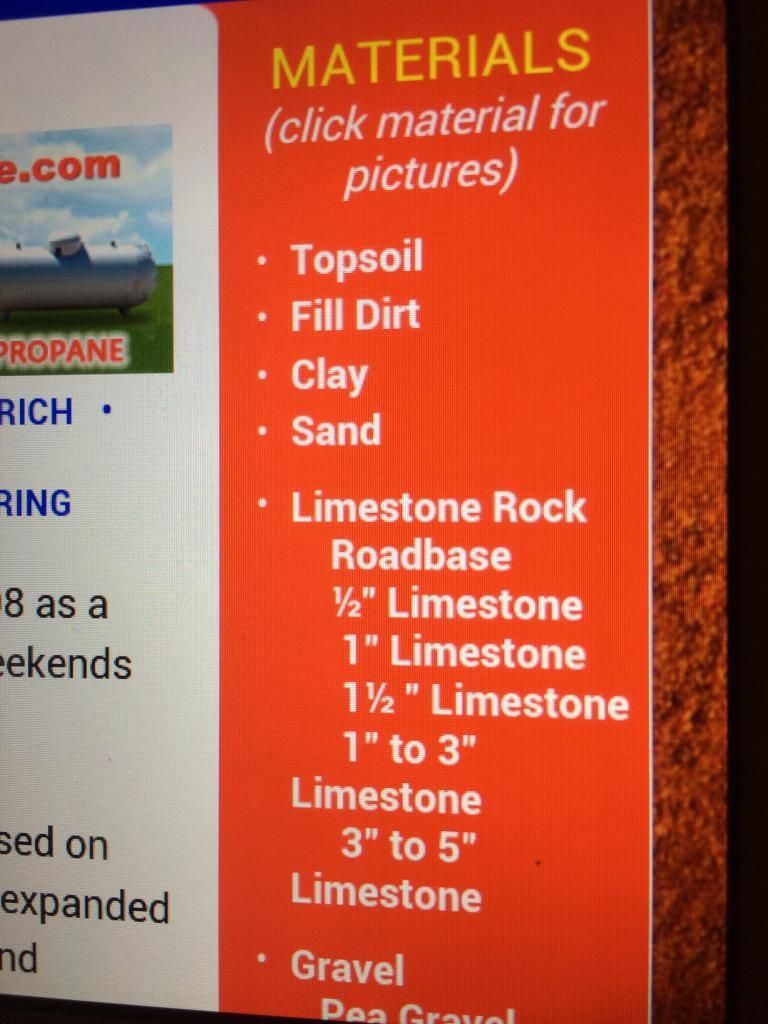
I called this aggregate supplier to confirm what was told to me and she referred me to their website. I asked her to confirm pricing from my previous call and the sales lady told me the same $600.00 for a 13 Ton load. Larger sizes up to 5" limestone per 13 ton load is $630.00. From 5" - 12" limestone per 13 ton load is $700.00. 18" Limestone is $750.00 per 13 ton load. Just out of curiosity I asked how much their pea gravel and rainbow rock (river)was. It is $600.00 per 13 ton load. Go figure.....That is $46.15/Ton. Then, she indicated that all of their aggregate (rock) was $600.00/13ton load....
One thing about buying crushed rock, you will immediately notice that pricing for rock with the fines left in is a lot cheaper per ton than rock that has been graded with the fines taken out. The higher cost is because they have to run the material over another set of screens to take the fines out.
But that does NOT mean that the rock with fines will actually be cheaper for your project. It depends.

If you need it to pack, like for a road finish, then the fines are needed so it will pack in all the voids with the fines.
But if you are just wanting the rock to go for a long ways or do not need the fines for your project, don't think you are getting the fines for almost free. Far from it.
Order one same tons size of load of each and have them piled side by side. The cleaned crushed rock (fines removed) will be considerably physically bigger than the ones with fines left in. That is because the fines are very heavy and fill in all the air pockets between the larger rocks.
So if the larger size rock is what you need without fines, order it without fines because even if it cost more per ton it will also go a lot further in whatever project you are doing because it weighs considerably less per cubic measure!
IMO Snrub is THE MAN when it comes to using stone for erosion control. Strongly consider his advice. I followed his advice for my pond and I went from having a muddy pond after a half inch of rain to having a clear pond even after 3 or 4 inches of rain. He knows this stuff!
About a year ago, I got an 11-ton load of maximum size 1-1/4 inch limestone with fines delivered for $200.00. There are several quarries within 25 miles. Most was used to cover the clay floor of my pole shed. About one ton or so I hauled to the pond.
Looks like I need to add some rock lining to my old pond.
My old refurbished pond is kind of my "trash" pond. It gets minimal management and has BH as well as GSF along with more desirable fish. So I really had no intention of spending the time or money on taking much care of it. But after seeing the erosion along the northern bank it has made a nice natural bench. So I think some time this summer I am going to drop some rock around at least the north side to stop the erosion.
First two pictures are of the north side where the bank erosion (from wind and waves) is happening. The third picture is of the south shore where there is a good stand of water primrose which seems to be keeping the erosion in check.
Water is pretty clear right now because during winter mostly north winds where the waves are hitting the south shore which is protected by the water primrose. But I am sure with more south winds of summer the bank erosion on the north shore will add to water turbidity if I do not get the rock lining done.
Description: Wave action eroding the bank and causing a clay "bench"


Description: South shore covered with water primrose (now dormant) protecting it from the erosion

Here is the results of adding some rock to prevent the bank erosion in the pictures of the previous post. I still need to do a little hand leveling with a rake or shovel to even it out but otherwise this is the amount of rock it will get.
I only did about a fourth the way around the pond where the wave action was causing problems. In the third picture of the previous post you will see dormant water primrose protecting the bank from erosion. Where I had the water primrose and no erosion I did not put the rock. The Primrose should come back this spring and protect the bank in those locations. If it doesn't, I'll add rock as needed.
A couple years ago I heard one comment where some people did not like the looks of the rock. I can appreciate that but can also vouch that in about three years the rock will not even be seen. Grass will grow up and cover it up where it is not even noticeable. The difference being with only grass wave action can still wash out the dirt among the roots and undercut the dam. With the rocks the grass roots will be interwoven in the rocks creating a solid wave barrier protecting the dam or shore line. It has worked well in my main pond.
The crushed limestone rocks used are what is called locally as "lateral rock". It is cleaned rock used in septic system drain fields. It is about 2-3" in diameter. In this one acre pond it should work well. In a big pond or lake with larger waves larger rock would be needed to keep it from washing away into deeper water.
Description: Showing rocks deposited to stop shore line and dam erosion pictured in the previous post.
.jpg)
I put rock on the dam as it has the longest fetch in the lake, plus the most dire consequences from erosion. Rock, or at least transporting rock, can be expensive!
By the way, Bob Lusk told me that it helps the pond if the rocks are of different sizes, as various crustaceans and fish will use them at different stages of their life. Adds forage for the big guys.
I put creek rock along my dam as the photo shows. The rock was hand picked so the sizes ranged from baseball size to as big as I could load. I can really see the benefit only a year later. In the photo you can see the uphill rocks were laid to be about 5 or 6 inches tall and the lower rocks were a bigger variety. Today the earth that has migrated down the dam is level with the top of the uphill rocks. My seeding efforts took very well, so this migration of dirt is mostly settling. This proved to me that rock perimeters really help. If it was not for the rock band, the dirt that is now being held back would be mud in the water. The main reason I put the rock in was for crawdads, but the erosion benefits would be worth it by itself.
.jpg)
Note the upsides down carpet under the rock. I am a pack rat and had saved (for years without the thought of its final destination)just enough scrap carpet to cross my dam . I was pretty proud to have had the carpet available, but even more so that it had found a use and I was relieved of the pile of "stuff" in the shop loft.
Old carpet is a great idea to put under the rock. Thanks for the pictures. They will help others giving consideration to using rock lining for their pond banks.
Nice job.
Over the winter had a small amount of erosion on the south shore line so I am adding some additional rock. The small amount of erosion made a nice 12-18" wide "bench" for the rock to sit on.
I had previously mostly focused on the north shore because our predominant summer south/ southwest winds caused turbidity that I could see happening. Being a snow bird I had not thought about what would happen during the winter and was not around to witness the winter time erosion from the NW winds. But some happened so I have been on a mission to nip it in the bud.
Also am using some larger rock than I have in the past on the areas that are exposed to the largest waves. I think my rock supplier calls it 4 by 5 (rocks that will pass through a 4"x5" square screen) with the fines screened out (so only large rocks).
I dump about a half bucket of my small tractor, then with the bucket at an angle approximating the slope of the pond back drag the rock up solid against the bank. Then I tamp it in place with the bucket.
Pictures below.
Note: water level is about 9" below full pool. At full pool the water will be within a couple inches of the top of the rocks. The low water level makes this a really good time to do this as I can see the bench and see what I am doing really well.
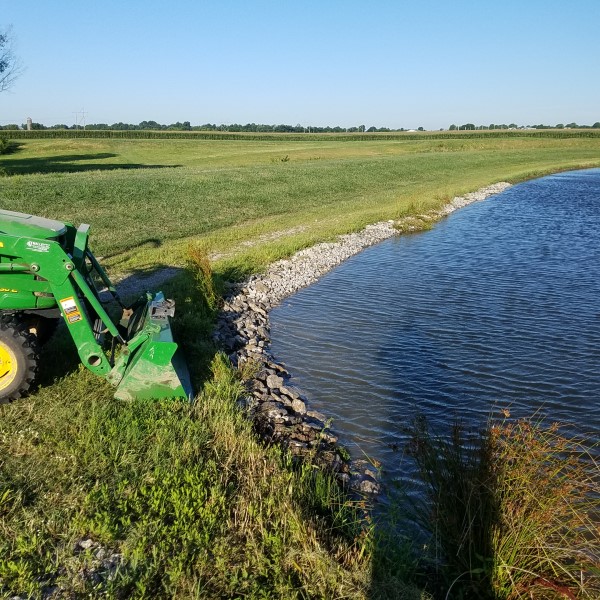
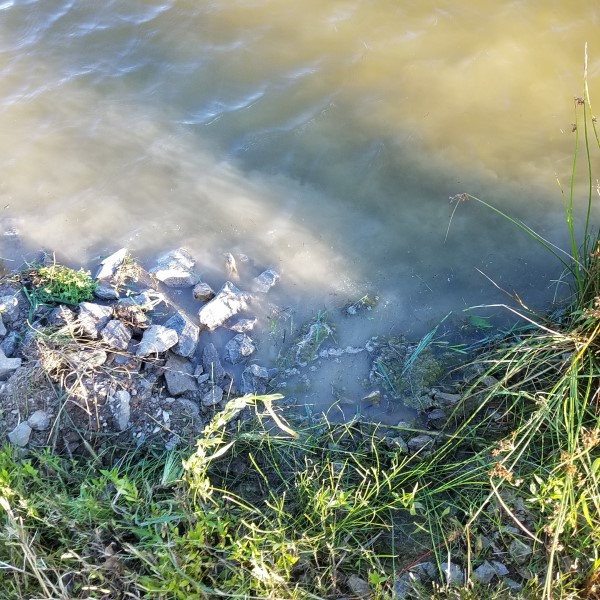

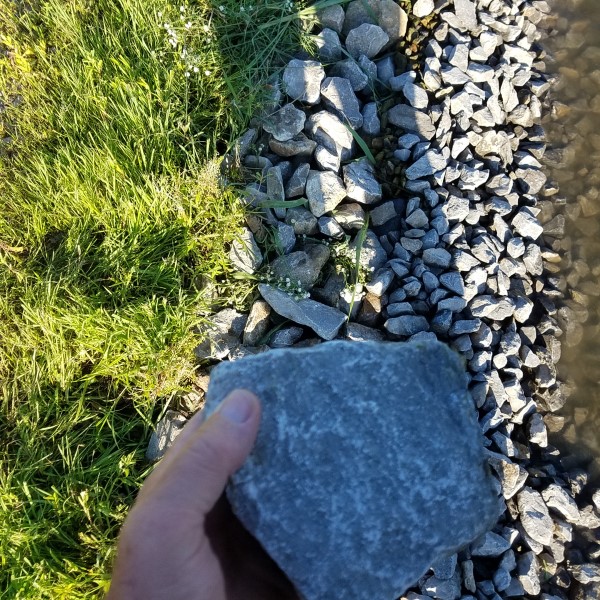
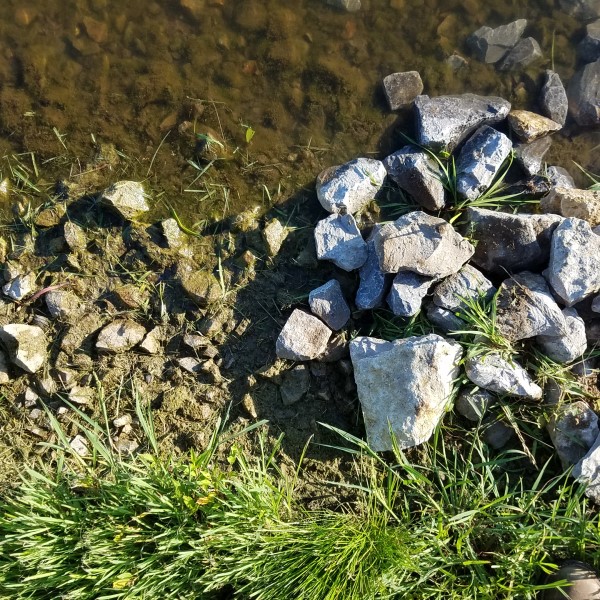










.jpg)
.jpg)




